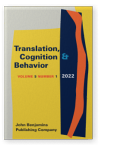Vol. 5:1 (2022) ► pp.1–26
Considerations of ecological validity in cognitive translation and interpreting studies
Renewed interest in research methods used in cognitive translation and interpreting studies (CTIS) has led to increased reflection on the nature of research and experimental design, internal and external validity, and the type and nature of experimental tasks. Of particular concern is the extent to which valid generalization can be made from empirical studies of translation, interpreting, and their associated cognitive behaviors as objects of study. This article traces the definition and history of ecological validity in the extant literature on research methods and philosophy of science, emphasizing three considerations: the experimental setting, the stimuli under investigation, and the behavioral response of participants. Subsequently, we discuss potential misunderstandings or misapplications of appeals to ecological validity, including mundane realism, naturalistic tasks, and various data collection methods. A final section describes key points to consider for research in CTIS. Throughout, the argument considers tradeoffs among various categories of validity as well as the importance of aligning experimental design with research goals. This extensive engagement with a singular aspect of validity is provided to encourage deeper reflection and better communication around the topic of ecological validity.
Article outline
- 1.Introduction
- 2.Definitions of ecological validity
- 2.1Alternative conception of ecological validity
- 3.Balancing risks to ecological validity
- 3.1Naturalistic tasks
- 3.2Mundane realism
- 3.3Data collection methods
- 4.Establishing ecological validity
- 4.1Define the relevant environment for experimentation and generalization
- 4.2Align the stimuli, variables, and measurement with the research purpose
- 4.3Consider influences and constraints on participant responses
- 5.Conclusion
-
References
